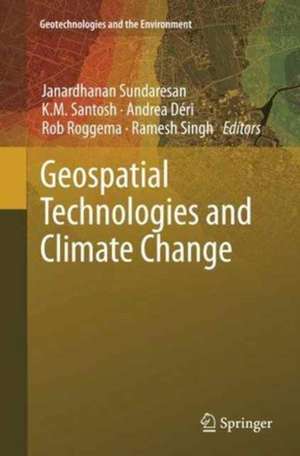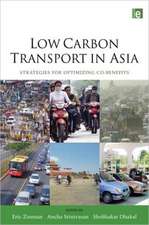Geospatial Technologies and Climate Change: Geotechnologies and the Environment, cartea 10
Editat de Janardhanan Sundaresan, K M Santosh, Andrea Déri, Rob Roggema, Ramesh Singhen Limba Engleză Paperback – 27 aug 2016
| Toate formatele și edițiile | Preț | Express |
|---|---|---|
| Paperback (1) | 562.47 lei 38-44 zile | |
| Springer International Publishing – 27 aug 2016 | 562.47 lei 38-44 zile | |
| Hardback (1) | 652.31 lei 6-8 săpt. | |
| Springer International Publishing – 3 ian 2014 | 652.31 lei 6-8 săpt. |
Din seria Geotechnologies and the Environment
- 15%
 Preț: 649.71 lei
Preț: 649.71 lei - 18%
 Preț: 1408.89 lei
Preț: 1408.89 lei - 18%
 Preț: 1007.49 lei
Preț: 1007.49 lei - 18%
 Preț: 945.79 lei
Preț: 945.79 lei - 20%
 Preț: 566.50 lei
Preț: 566.50 lei - 18%
 Preț: 952.09 lei
Preț: 952.09 lei - 18%
 Preț: 948.92 lei
Preț: 948.92 lei - 15%
 Preț: 652.31 lei
Preț: 652.31 lei - 18%
 Preț: 951.77 lei
Preț: 951.77 lei - 15%
 Preț: 639.25 lei
Preț: 639.25 lei - 15%
 Preț: 652.17 lei
Preț: 652.17 lei - 24%
 Preț: 746.98 lei
Preț: 746.98 lei - 24%
 Preț: 778.70 lei
Preț: 778.70 lei - 18%
 Preț: 952.72 lei
Preț: 952.72 lei - 18%
 Preț: 968.34 lei
Preț: 968.34 lei - 24%
 Preț: 790.70 lei
Preț: 790.70 lei - 18%
 Preț: 995.63 lei
Preț: 995.63 lei - 18%
 Preț: 886.92 lei
Preț: 886.92 lei - 5%
 Preț: 1106.69 lei
Preț: 1106.69 lei - 18%
 Preț: 1215.04 lei
Preț: 1215.04 lei - 15%
 Preț: 636.12 lei
Preț: 636.12 lei - 18%
 Preț: 967.08 lei
Preț: 967.08 lei - 15%
 Preț: 530.42 lei
Preț: 530.42 lei
Preț: 562.47 lei
Preț vechi: 703.09 lei
-20% Nou
Puncte Express: 844
Preț estimativ în valută:
107.63€ • 112.67$ • 89.06£
107.63€ • 112.67$ • 89.06£
Carte tipărită la comandă
Livrare economică 01-07 aprilie
Preluare comenzi: 021 569.72.76
Specificații
ISBN-13: 9783319343846
ISBN-10: 331934384X
Pagini: 315
Ilustrații: XVI, 299 p. 120 illus., 87 illus. in color.
Dimensiuni: 155 x 235 mm
Ediția:Softcover reprint of the original 1st ed. 2014
Editura: Springer International Publishing
Colecția Springer
Seria Geotechnologies and the Environment
Locul publicării:Cham, Switzerland
ISBN-10: 331934384X
Pagini: 315
Ilustrații: XVI, 299 p. 120 illus., 87 illus. in color.
Dimensiuni: 155 x 235 mm
Ediția:Softcover reprint of the original 1st ed. 2014
Editura: Springer International Publishing
Colecția Springer
Seria Geotechnologies and the Environment
Locul publicării:Cham, Switzerland
Cuprins
Geospatial Technologies as Impact Assessment Tools in Scoping and Monitoring the Impact of Climate Change.- Climate change around the world: Australia, the Netherlands and India.- Dust storms over Indo-Gangetic basin and their impact on Regional climate, precipitation, Himalayan snow/glaciers and Ocean-Ecology supplement.- Impact of Climate Change on Coral Reefs.- Landslide disaster management.- Studies on mangrove Regeneration in tsunami affected area of port blair, south Andaman using in situ and remote sensing techniques.- Phyto and Zooplankton community assemblages of Car Nicobar Islands, Andaman Sea, India and its Significance with Climatic Change.- Application of GIS and Remote Sensing in Landslide Hazard Zonation.- Geospatial Technologies as Decision Support Tools in Planning for Adaptation and Mitigation.- Swarm Planning for Climate Change: How Transformations can be Achieved.- Maps, Knowledge, Resilience: Application of ArcGIS in building small island’s resilience to Climate Change.- Evaluation of remote-sensing-based potential fishing zones (PFZs) advisories along Mumbai coast.- Application of geo-spatial technologies in Coastal Vulnerability studies due to Sea Level Rise (SLR) along the select regions of Indian coast.- Geospatial Technologies: Exploring their Technical Potential in Climate Change Research.- Generation of Morphometric Information Using Satellite Images Satellite Geoid/Gravity for Offshore Exploration.- Modelling of climate and climate projection: A data intensive paradigm.- DGPS Principles, Errors and Achievable Accuracies.- Fundamentals of Geographical Information System (GIS), Map Sources and Digital Map Preparation.- Generation of Morphometric Information Using Satellite Images.- Fundamentals of Remotesensing.
Notă biografică
The authors are key scientists on geospatial technologies applied to climate change, working from four continents - America (USA), Europe (UK), Australia and Asia (India)
Textul de pe ultima copertă
“Geospatial Technologies and Climate Change” is a scholarly compilation of seventeen chapters from researchers working on climate change related research in five countries of four continents. Geospatial technologies, synergetic applications of remote sensing and geographical information systems, offer versatile cross-scale tools to study climate change, the climate system’s changes over decades, and their impacts on social- and ecological systems. A wide variety of climate change applications and the most advanced tools for climate change research are presented in this volume. The detailed treatment of the topic is framed in the paradigm of spatial planning for mitigation and adaptation. Through multifunctional and flexible thinking the authors investigate the dynamics of natural systems and suggest planning ahead for longer terms, as changes of the climate unfold only over longer periods. The book argues that technological innovations for climate change mitigation and adaptation should begin locally.
Three strands of spatially defined climate change research come together in this volume. The first part explores geospatial technologies as assessment tools that play important roles in scoping and monitoring climate change impacts. The second part reviews geospatial technologies as decision support tools applied in planning for adaptation and mitigation. The third part provides an introduction to the basics of geospatial technologies and uncovers their technical potential in advanced climate change research.
Designed for students, academics and decision-makers, the volume accounts for the leading currents of thought in applying geospatial technologies in climate change research and adaptation. By demonstrating how diversity of discovery methods can broaden our knowledge, from design charettes through hands-on engagement with the local environment to interpreting satellite imagery, the authors emphasize the importance ofinter-disciplinary approaches in addressing uncertainties over climate change. The broad and fresh perspectives of the authors make this volume an invaluable guide in innovative application of geospatial technologies in climate change research.
Three strands of spatially defined climate change research come together in this volume. The first part explores geospatial technologies as assessment tools that play important roles in scoping and monitoring climate change impacts. The second part reviews geospatial technologies as decision support tools applied in planning for adaptation and mitigation. The third part provides an introduction to the basics of geospatial technologies and uncovers their technical potential in advanced climate change research.
Designed for students, academics and decision-makers, the volume accounts for the leading currents of thought in applying geospatial technologies in climate change research and adaptation. By demonstrating how diversity of discovery methods can broaden our knowledge, from design charettes through hands-on engagement with the local environment to interpreting satellite imagery, the authors emphasize the importance ofinter-disciplinary approaches in addressing uncertainties over climate change. The broad and fresh perspectives of the authors make this volume an invaluable guide in innovative application of geospatial technologies in climate change research.
Caracteristici
Describes the basics of geospatial technologies, along with climate change applications Presents important concepts on spatial planning of adaptive and resilient nature Provides unique information for researchers on DGPS Principles, Errors and Achievable Accuracies Written by key scientists from four continents - America (USA), Europe (UK), Australia and Asia (India)











